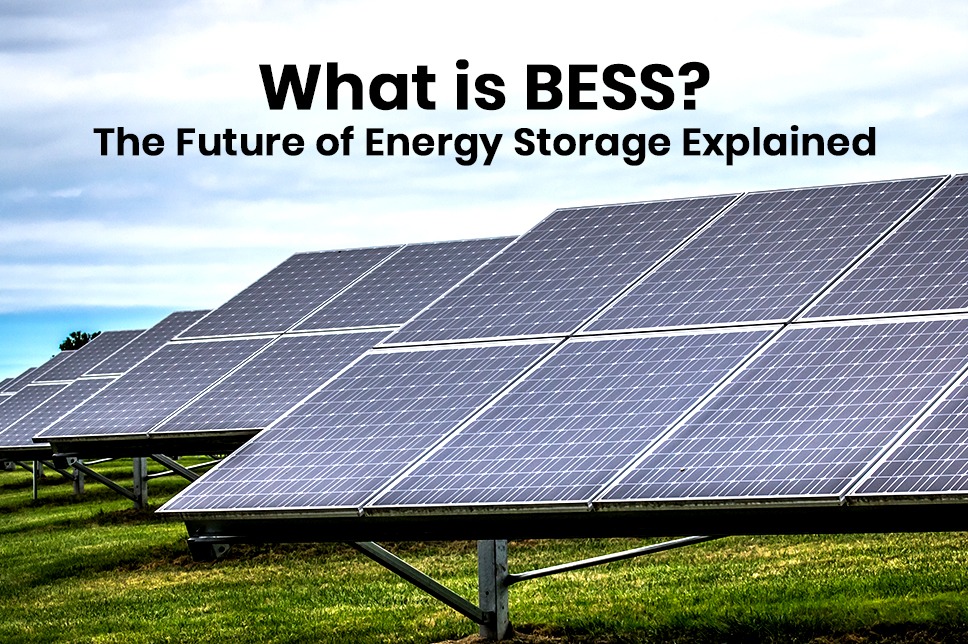
What is BESS? The Future of Energy Storage Explained
The global energy landscape is changing rapidly. Sources such as solar and wind become the mainstream sources, a challenge continues to limit their full potential – storage. How can we store clean energy for a time when the sun does not shine or the wind does not blow?
This is where BESS, or Battery Energy Storage System, comes in. It is being hailed as the future of energy storage and one of the most critical technologies for achieving energy independence and stability.
In this blog, we will explain what a BESS is, how it works, its benefits, applications and why it shapes the future of energy.
What is BESS?
BESS is the acronym for Battery Energy Storage System. Simply put, it is a battery storage power station that allows electricity to be stored in rechargeable batteries and then released when needed.
Unlike traditional power plants, which produce electricity on demand, renewable sources such as solar and wind are intermittent – their output depends on natural conditions. The challenge addresses this by storing more energy during production and supplying it during periods of high demand or low pay generation.
Think of the BESS as a huge power bank, but at a large, grid-scale level.
How Does BESS Work?
The battery energy storage system works together with several components:
- Battery : The core unit where the energy is stored. Lithium-ion is the most common battery chemistry today, but other options like sodium-ion and flow batteries are emerging.
- Battery Management System (BMS) : Battery controls and monitors batteries to ensure safe operation, prevent overheating, and optimise operation.
- Inverter : DC power stored in batteries for use in homes, industries or grids converts to AC power.
- Energy Management System (EMS) : Software that determines when to store Energy, when to release it and how to effectively adjust the demand.
The process is simple: when the renewable energy is high, the electricity charges the BESS. When the demand increases or the renewable output arrives, the stored electricity is discharged to supply.
Benefits of BESS
BESS are increasingly being used worldwide because of their almost limitless applications and advantages.
Some of the most important are:
Grid Stability
BESS serves to maintain grid stability by balancing supply and demand within seconds, thereby preventing blackouts and voltage fluctuations from occurring.
Renewable Integration
BESS stores solar and wind energy to ensure that renewables can be encouraged more without the need to worry about their intermittent nature.
Peak Shaving
The industries and utilities use storage during periods of high demand, hence reducing dependency on peak-hour electricity, which is very expensive.
Energy Independence
BESS helps businesses, towns, or homes to be less reliant on the grid when coupled with a solar or wind-based system.
Environmental Impact
BESS would limit the use of fossil-fueled backup power demand and thus decrease carbon emissions toward clean energy aims.
Applications of BESS
BESS has a wide array of applications across industries.
- Utility-Scale : BESS projects are there to stabilise power grids at large scales and store renewable energy for cities.
- Commercial & Industrial : BESS installations help factories, data centres, and hospitals to minimise operational costs and avoid interruption in power supply.
- Residential : A small BESS can be paired with rooftop solar to allow homeowners to consume the solar energy at night.
- Microgrid : Remote communities and islands can operate independent, renewable-powered grids with BESS.
- EV Charging Infrastructure : BESS balances sudden surges in demand at fast-charging stations.
Challenges in BESS Adoption
While the technology appears promising, a few challenges might appear:
- High Investment : Although the prices for BESS projects, particularly those of large sizes, fall but require heavy initial investment.
- Battery Ageing : Lithium-ion batteries, as they are about to expire, tend to decrease in storage capacity.
- Recycling & Disposal : Sustainable recycling techniques for the used batteries pose another concern.
- Policy & Regulation : Clear frameworks and regulations, which would allow BESS to be integrated into the grid, are yet to be developed in many jurisdictions.
Solving these would be central to the global promotion of BESS.
What’s the Future of BESS?
India’s Leading Solar Company believes the future of BESS looks bright, with governments, businesses, and investors showing strong interest.
Here are some trends shaping its growth:
- Declining Battery Prices : As manufacturing scales up and new chemistries emerge, costs will continue to fall, making BESS more affordable.
- Advanced Technologies : Solid-state batteries and flow batteries promise longer lifespans and higher efficiency.
- Policy Support : Countries are introducing incentives, subsidies, and regulatory frameworks to promote the adoption of BESS.
- Global Investments : Billions are being invested in gigafactories and large-scale storage projects worldwide.
By 2030, India’s Leading Solar Company has predicted that BESS will be part of the mainstream structure.
The Bottom Line
Setting a foundation is not just an emergency tool; it is a transformative system for the entire energy ecosystem, ensuring the reliability of power, increasing the use of renewable energy zones, reducing costs, and paving the way for a cleaner and sustainable future. As renewable energy is increasing, the role of the BESS is also changing. From stabilising grids to powering homes and industries, BESS represents the next big leap in how we generate, store, and consume electricity.
India’s Leading Solar Company believes that the future of energy is not just renewable, but renewable with the collection. And the BESS is at the forefront of these efforts.
